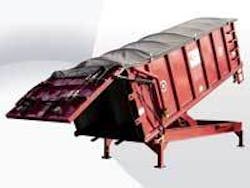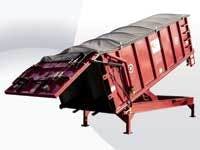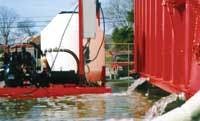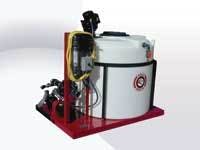Processing Wastewater Sludge Using Dewatering Containers
by Russ Caughman
The relative costs of dewatering equipment varies widely and is directly related to the processing rate. For smaller utilities who need to dewater sludge in batches, dewatering containers are an alternative that can be relatively inexpensive and simple when compared to other technologies on the market.
The most common type of dewatering container is based on a roll-off box design, although any type of container that is water tight can be made into a “container filter”. This includes containers that are commonly referred to as self-dumping hoppers, front, side and rear loaders, and lugger boxes. There are basically two varieties of these dewatering containers: those that have permanent filters and those that use disposable filters.
Within the permanent filter category there are multiple configurations of filter orientation, materials of construction, and filter porosity. The most common type of disposable filter is a needle punched polypropylene geotextile. This material is typically folded in half lengthwise and the ends sewn together creating an “envelope”. It is then inserted into a container with the top edges folded over the top sides of the container.
The support structure for the disposable filters can be bar grating, expanded metal, perforated plate or other rigid porous material that can support the weight of the solids. There are usually drain ports in the container through which the effluent is discharged. In the case of a roll-off type disposable filter box, the door can simply be left slightly open (but secured with a latch).
Regarding the permanent filter type dewatering box, there is usually a bottom filter and filter support as well as side wall filters. To gain more filter area per unit volume, filters and filter supports are often added to the front wall and back wall, and in some cases a center panel is added with filter media on both sides. The filter support panels are either bolted or welded into the container. The filter media is typically riveted or bolted on top of the support panels.
Originally dewatering boxes were used on a variety of waste streams and were allowed to gravity drain in whatever time frame was necessary to reach the desired cake dryness. One innovation was to incorporate a vacuum assist to the dewatering process, which in many cases greatly accelerated the drainage rate and produced drier cake.
The vacuum process is only practical in permanent filter type containers and is usually accomplished by separating the bottom floor filter cavity from the cavity to which the vertically oriented filters drain. This allows for a vacuum to be applied to the bottom filter cavity. This “gravity/vacuum” design works particularly well with sandy sludge or waste streams made up primarily of non-deformable solids. The over-all benefit is faster dewatering and drier cake.
One application in which this type of dewatering box is used is grit and screenings dewatering at wastewater treatment plants. Grit that settles out in sewage pipes is basically sandy in nature and forms a fairly permeable cake allowing the residual liquid to be “vacuumed” from it.
Liquid waste streams that are made up of de-formable solids, such as biosolids, do not readily dewater without the addition of chemical treatment. Coagulants and flocculants are the two main types of chemicals used in this process.
The addition of chemical treatment to liquid waste streams has greatly improved the ability of dewatering containers to perform their task. The process of flocculation causes the fine solids in the sludge to clump together forming large masses that are caught by the filter media in the dewatering container. This process also increases the porosity of the cake that forms in the container.
Without the addition of polymer, a biosolids waste stream will pass solids through a given filter media until it forms a thin cake on the media, at which point it becomes “blinded” allowing no more water or solids to pass through. A waste sludge can sit in a dewatering container for a long time and not dewater an appreciable amount, depending mainly on evaporation not separation to perform the “dewatering” process. Polymer can reduce the dewatering time from months to 24 hours and less.
Batch Operation
Dewatering containers are batch type devices and therefore are not designed to keep up with a continuous liquid flow. There are numerous applications in wastewater treatment that don’t require devices that can continually remove solids. For example, sludge from clarifiers is typically removed periodically, not continuously. A specific application for dewatering containers that has grown in recent years is the dewatering of digested sludge at wastewater treatment plants.
The main reason to choose a dewatering container is their simple operation. The dewatering container itself has no moving parts. The waste is processed in the same unit in which it is hauled away and dumped, thus limiting the handling of the sludge. The dewatering box will give volume reductions in the 80% to 95% range depending on the percent solids in the sludge. The cake produced by the dewatering box will pass the “paint filter” test and can go to the local landfill. The effluent water from the dewatering box can go back to the headworks of the plant virtually devoid of solids.
The container is almost maintenance free - cleaning the screens with a water hose after dumping helps, but is not necessarily required every time the container is dumped. The units can have tarps or roofs on them to make them weather and odor resistant. They can be trailer-mounted for easy hauling, or permanently mounted on a tipping stand so that the cake can be un-loaded on site -- whether stockpiling it or dumping it into another container or dump truck.
Polymer System
An appropriate polymer make-up and delivery system is essential to smooth operation. Batch type polymer systems are preferable to in-line type units. Batch polymer systems will have a mixing tank (or two) with mechanical agitator, a dilute polymer injection pump, and a static mixer. Neat polymer is added to the mix tank after it is filled with water. The usual dilution ratio is 1 part of polymer to 200 parts of water. The polymer and water solution is mixed for 20 to 30 minutes to activate the polymer.
This solution is then pumped into the sludge stream as it passes through the static mixer on its way to the dewatering container. The static mixer induces turbulent flow to the sludge putting the polymer solution into intimate contact with the sludge solids. This causes them to flocculate, i.e., form large sponge-like masses that now are suspended in clear water. When this mixture enters the dewatering container, the mass of solids is held back by the filter media while the water passes through to drainage ports and out of the container. The solids continue to build a “cake” until the container is full, at which time it is allowed to sit idle and drain.
The length of time necessary for the dewatering process is typically a minimum of 24 hours: 6-8 hours of filling and 16+ hours to drain. Water drains from the box while the filling process is occurring but normally the drainage rate falls off as the cake begins to build, so eventually the container fills up and the sludge pump must be shut off.
The fill cycles times are related to the sludge pump flow rate, the size of the dewatering container, and the percent solids in the sludge. For example, a 30 cu. yd. unit could be filled at 250 gpm or 50 gpm. At the higher sludge flow rate the container might be filled in one hour. It will then be allowed to sit and drain for 1.5-2 hours, then filled again, etc. At the lower flow rate, 50 gpm, it might take 6-7 hours to fill the same container, at which time the operator might shut down for the evening and let the box drain overnight.
In general, with a 1% sludge a dewatering box will process 1,000 gallons times the cu.yd. of the box. So, if the dewatering container is a 30 cu.yd. unit it will process 30,000 gallons per day. This number is lowered as the % solids increases. In order to process that amount per day the container must be dumped every day. This is not always practical so the containers are often sized up or their number increased to allow for dumping less frequently. The units that are permanently mounted on tipping stands are more amenable to being dumped every day, since transporting them is not involved.
Operating costs for the dewatering containers include the cost of polymer, which normally ranges from $.002 to $.005/gallon, tipping fees at the landfill and the transportation cost of moving the cake to the landfill. Maintenance costs are negligible due to the filter media’s long life expectancy, which with normal wear and tear should be longer than five years. The batch type polymer systems have two moving parts, the agitator and pump which are low cost items and will last for years.
Dewatering boxes used for WWTP sludge can come in sizes ranging from 3 cu.yd. to 40 cu.yd. The roll-off type are available in 15, 20, 25, 30 and 40 cu.yd. capacities, while the trailer-mounted and tipping stand mounted units are built in 3, 5, 7, 12, 15, 20, 25, 30, and 40 cubic yard sizes. Polymer systems have mix tank sizes beginning at 75 gallons up to 1100 gallons and can treat sludge flows from 50 gpm (and less) to over 400 gpm.
About the Author:
Russ Caughman is the vice president of Flo Trend Systems, Houston, TX. He can be contacted via e-mail at [email protected].



